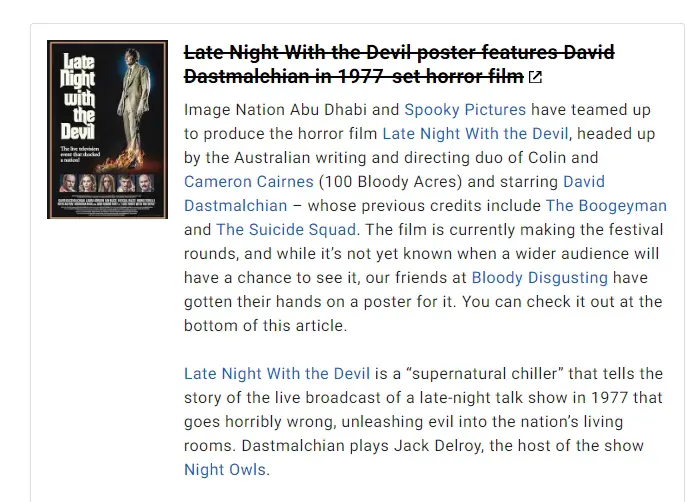AI Meets Cinema: The 'Late Night with the Devil' Controversy

In the cinematic landscape, “Late Night with the Devil” emerges as a beacon of contemporary filmmaking, marrying the eerie allure of horror with the cutting-edge intrigue of AI. This film, set against the backdrop of a 1970s talk show, invites the devil himself on air, unraveling into a clever satire spun from found footage. As AI brushes its digital strokes across the canvas of this movie, it ignites conversations far beyond the confines of horror, challenging our perceptions of artistry, authenticity, and the human touch in the age of machines.
AI Meets Cinema: The ‘Late Night with the Devil’ Controversy” delves into the nuanced integration of AI in the horror film, sparking debate over creativity, authenticity, and the future of AI in storytelling. As the film blends traditional horror with innovative technology, it becomes a focal point for discussions on the evolving landscape of cinema.
Table of Contents
What Is 'Late Night with the Devil'?
“Late Night with the Devil” is a riveting supernatural thriller that captivates audiences with its unique premise set in the 1970s. Starring David Dastmalchian as the ambitious talk show host Jack Delroy, the film unravels on the live broadcast stage of a late-night show, where the host invites a guest claiming to be Satan himself. What begins as a daring stunt to skyrocket the show’s ratings spirals into a nightmarish ordeal, unleashing unspeakable evil onto the nation’s screens. Directed and edited by the Cairnes brothers, known for their flair in genre maverick filmmaking, “Late Night with the Devil” is a clever satire that blends found footage techniques with the aesthetics and mood of ’70s television, creating a compelling narrative that is both a nod to classic horror tropes and a fresh take on the genre.

The Role of AI in the Movie
Enhancing Narrative Complexity
AI in “Late Night with the Devil” serves as a crucial tool in deepening the narrative complexity, allowing for intricate plot development and unexpected twists that keep viewers on the edge of their seats. The use of AI-driven analysis helps to craft dialogues and scenarios that are not only unpredictable but also resonant with the thematic essence of the film.
Creating a Realistic ’70s Ambiance
One of the standout roles of AI in the film is its ability to authentically recreate the ’70s ambiance. From the set design and costumes to the color grading and film grain effects, AI algorithms analyze and apply historical data and visual styles, ensuring that every frame feels like a genuine artifact from the era.
Facilitating Audience Immersion
AI’s contribution extends to enhancing viewer immersion, employing sound design and visual effects that subtly manipulate the audience’s emotional responses. Through carefully calibrated AI interventions, the film achieves a heightened sense of tension and dread, drawing viewers deeper into its unsettling narrative.
Public Reaction to AI Integration
Intrigue and Appreciation
The use of AI in “Late Night with the Devil” has sparked intrigue and appreciation among audiences and critics alike. Many commend the film for its innovative approach to storytelling and its ability to seamlessly blend technology with creative expression, offering a fresh perspective on the possibilities of AI in cinema.
Concerns Over Authenticity
Despite the positive reception, some express concerns over the authenticity of AI-generated content, questioning whether technology can truly capture the nuanced human touch that defines the horror genre. This debate highlights the ongoing conversation about the role and limitations of AI in artistic creation.
Curiosity About Future Implications
The film also raises curiosity about the future implications of AI in cinematic creation, prompting discussions on how technology might further transform the industry. Audiences are keenly interested in the potential of AI to revolutionize not just horror but all genres of filmmaking, signaling a pivotal moment in the evolution of cinema.
Ethical Considerations of AI in Art
The integration of artificial intelligence (AI) into the realm of art, exemplified by “Late Night with the Devil,” brings forth a complex tapestry of ethical considerations. As AI continues to blur the lines between human and machine-made art, it raises questions about originality, authorship, and the intrinsic value of art itself. These considerations challenge traditional perceptions and push us to redefine the boundaries of creativity.
Authorship and Originality
The question of who the true author of AI-generated art is—whether it’s the programmer, the AI, or a collaborative effort—remains a topic of debate. This discussion extends beyond mere credit to encompass the deeper issue of originality in art produced by algorithms trained on existing human-created works. Can AI truly create something original, or is it merely reassembling the creativity of others?
Impact on Human Artists
AI’s capability to produce art also brings about concerns regarding the impact on human artists. There’s a growing apprehension that AI could overshadow human creativity, making the human artist less relevant. However, this perspective often overlooks the potential of AI as a tool for augmenting human creativity rather than replacing it, suggesting a future where AI and artists collaborate.
Ethical Use of Data
The ethical use of data in training AI systems for art creation is another significant concern. Many AI algorithms learn from vast datasets of artwork, raising questions about consent and compensation for the artists whose works contribute to these datasets. Ensuring fair use and acknowledging the contributions of human artists to AI’s learning process are crucial steps toward ethically integrating AI into art.
Industry Response
The film industry’s response to AI’s burgeoning role in cinema, as seen through “Late Night with the Devil,” offers a glimpse into the future of filmmaking. From excitement and innovation to caution and skepticism, the industry’s reactions are as varied as they are insightful, indicating a period of significant transition and adaptation.
Embracing AI for Enhanced Creativity
Many in the industry view AI as a groundbreaking tool that can enhance creative processes, offering new ways to tell stories and create immersive experiences. This optimistic stance focuses on the potential for AI to unlock new creative possibilities, allowing filmmakers to explore narratives and visual styles that were previously out of reach.
Concerns Over Authenticity
Conversely, there’s a palpable concern about the authenticity of AI-assisted creations. Critics argue that films heavily reliant on AI may lack the emotional depth and authenticity that come from purely human creativity. This viewpoint underscores the importance of maintaining a balance between leveraging AI’s capabilities and preserving the human essence of storytelling.
Training and Adaptation
The industry’s response also includes a focus on training and adapting to incorporate AI into the filmmaking process effectively. Recognizing AI’s potential to revolutionize the industry, many studios and filmmakers are investing in understanding AI technology, exploring how it can be integrated into various stages of production without diminishing the art of cinema.
Future of AI in Cinematic Creation
The trajectory of AI in cinematic creation, propelled by pioneering films like “Late Night with the Devil,” points toward a future rich with potential and fraught with challenges. As AI continues to evolve, its impact on filmmaking is poised to deepen, reshaping the landscape of cinema in profound ways.
Collaborative Storytelling
The future of AI in cinema hints at a more collaborative form of storytelling, where AI and human creativity merge to produce narratives with unprecedented depth and complexity. This partnership could redefine narrative structures, character development, and visual storytelling, offering audiences new and engaging cinematic experiences.
Democratization of Filmmaking
AI also promises to democratize filmmaking by making sophisticated production tools more accessible to independent filmmakers and newcomers. This democratization could lead to a surge in diverse voices and stories within the industry, breaking down barriers to entry and fostering a more inclusive cinematic landscape.
Ethical and Artistic Challenges
As AI becomes more ingrained in the creative process, the film industry will face ongoing ethical and artistic challenges. Navigating these challenges will require a concerted effort to establish guidelines that encourage the responsible use of AI in art, ensuring that technology serves to enhance rather than diminish the human experience of cinema.
Comparative Analysis: 'Late Night with the Devil' vs. Traditional Horror
In contrasting “Late Night with the Devil” with its traditional horror counterparts, we unveil a rich tapestry of evolution, challenge, and continuity. This offering insights into how technology can simultaneously disrupt and enrich storytelling traditions.
Blending Tradition with Innovation
Marrying classic horror elements with AI’s capabilities.
- Integration of AI-generated content enhances atmospheric tension.
- Maintains traditional narrative arcs, ensuring familiarity amidst innovation.
This juxtaposition illustrates how “Late Night with the Devil” pays homage to horror’s rich legacy while steering the genre into new waters. The film skillfully balances the expected tropes with unforeseen twists, courtesy of AI, presenting a model for how technology can serve as a complement rather than a replacement for human creativity.
Impact on Audience Experience
How AI shapes viewer engagement with horror.
- AI introduces a layer of unpredictability, enhancing suspense.
- Potential for personalized horror experiences based on viewer reactions.
The film’s use of AI not only revitalizes the genre for long-time fans but also attracts a new audience intrigued by the intersection of technology and narrative. This evolution in storytelling mechanics invites viewers to experience horror through a fresh lens, where the anticipation of AI’s influence adds a novel dimension to the thrill.
Authenticity and Artifice
Navigating the balance between genuine storytelling and AI intervention.
- Concerns over the authenticity of AI-generated horror elements.
- Potential for AI to detract from the human-centric essence of storytelling.
While “Late Night with the Devil” showcases the potential of AI in enhancing cinematic creation, it also prompts reflection on what constitutes the core of horror. The genre, rooted in evoking primal emotions, faces a unique challenge in integrating AI without compromising the intimate, often personal nature of fear.
Conclusion
“Late Night with the Devil” emerges not just as a film but as a harbinger of the evolving relationship between AI and cinema. It sparks a vital conversation on the future of artistic creation, urging us to reconsider the role of technology in storytelling. As we venture further into this symbiosis of human creativity and artificial intelligence, the film stands as both a testament and a question mark—challenging us to envision a cinematic world where technology amplifies our tales without silencing the human voice at their heart.

